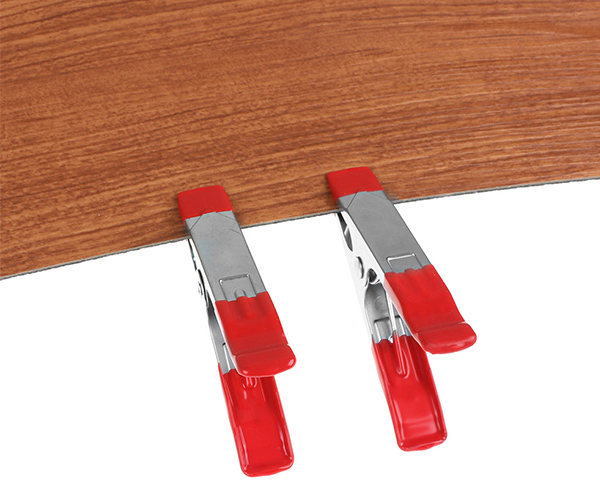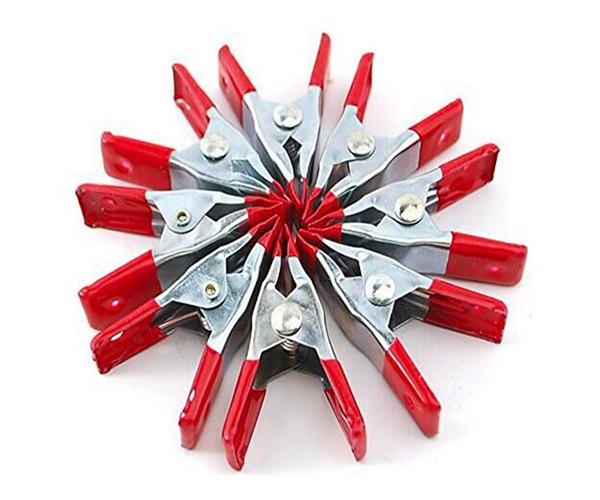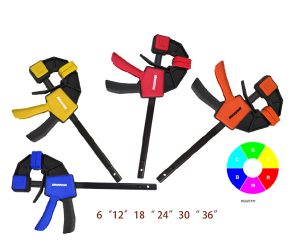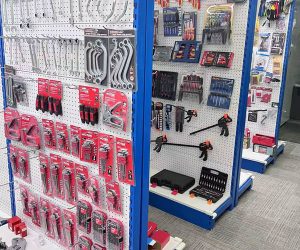Spring clamps are small but powerful tools that you can use to secure materials during a wide range of projects. Whether you’re working on a DIY home improvement project, car repairs, or woodworking, the spring clamp proves itself to be indispensable. But what exactly is a spring clamp, and why is it so valuable? In this article, we’ll explore what a spring clamp is, how it works, and the many reasons why you should keep one in your toolkit.
1. What is a Spring Clamp?
A spring clamp is a type of tool that uses the tension of a spring to hold objects securely in place. It consists of two arms connected by a strong spring, which provides the pressure needed to clamp down on materials. This pressure is adjustable, allowing you to apply varying amounts of force depending on the task at hand. The simplicity and functionality of spring clamps make them incredibly useful in various situations, from holding pieces of wood together during glue drying to securing fabrics or other materials.
But here’s the kicker: despite their simple design, spring clamps are surprisingly strong and reliable. They come in a variety of sizes, making them suitable for everything from small, delicate tasks to heavy-duty jobs. The versatility of the spring clamp is one reason why it is considered an essential tool in many professional and DIY toolkits.
Table 1: Common Uses for Spring Clamps
| Use Case | Description | Example Projects |
|---|---|---|
| Woodworking | Used to hold wood pieces together | Securing pieces for glueing or sanding |
| Car Repairs | Helps to hold parts in place during repairs | Clamping car body parts or securing fabric for repairs |
| Craft Projects | Ideal for temporary securing during crafting | Holding fabric, paper, or leather while working |
| Painting and Gluing | Holds objects together while adhesives dry | Clamping artwork to a surface or materials for gluing |
2. How Does a Spring Clamp Work?
Ready for the good part? The magic of a spring clamp lies in the spring mechanism that allows the two arms to open and close with a firm grip. When you apply pressure, the spring compresses, and the arms open. When you release the pressure, the spring causes the arms to clamp together tightly, holding the materials in place.
Spring clamps are known for their simplicity, yet they deliver powerful and consistent clamping force. This makes them much easier and faster to use compared to other types of clamps, like C-clamps, that require manual tightening. Additionally, their quick-release mechanism means that you can remove the clamp with minimal effort, saving you time and frustration during your projects.
This is where it gets interesting: the design of the spring clamp allows it to be highly effective for quick, temporary holds without the need for complex setup or additional tools. Whether you’re fixing something for a short period or need to leave the clamp in place for a more extended time, spring clamps are your go-to tool.
Table 2: Benefits of Using a Spring Clamp Over Other Clamps
| Feature | Spring Clamp | C-Clamp | Bar Clamp |
|---|---|---|---|
| Ease of Use | Simple and quick | Requires tightening | Requires adjustments |
| Speed of Setup | Fast | Slow | Slow |
| Clamping Force | Moderate to High | High | Moderate to High |
| Best for | Temporary holds | Heavy-duty work | Large projects |
3. What Are the Different Types of Spring Clamps?
What’s the real story when it comes to the different types of spring clamps? Just like most tools, spring clamps come in various sizes and designs, making them adaptable to different tasks. Some spring clamps are designed for small, delicate work, while others are intended for heavy-duty applications.
There are a few key types you need to know. First, you have the light-duty spring clamp, which is typically smaller in size and used for light tasks such as securing paper or small pieces of fabric. Then there are heavy-duty spring clamps, which are larger and stronger, able to hold heavier materials like thick pieces of wood or metal during repairs. Finally, specialty spring clamps are designed for specific tasks, such as clamping round objects or working with softer materials.
This variety allows you to choose the right clamp for the job, ensuring you have the best tool for any project, big or small.
Table 3: Types of Spring Clamps
| Type | Size | Common Uses |
|---|---|---|
| Light-duty spring clamp | Small | Crafting, small woodworking tasks |
| Heavy-duty spring clamp | Large | Holding wood, metal, or thick materials |
| Specialty spring clamp | Varies | For specific materials or shapes |
4. What Are the Common Materials Used in Spring Clamps?
What’s the deal with the materials used in spring clamps? Well, like most tools, the materials that make up a spring clamp can affect its performance, durability, and price. Spring clamps are typically made of three materials: steel, plastic, and composite materials. Each type offers unique advantages depending on your needs.
Steel spring clamps are strong and durable, ideal for heavy-duty tasks. They can withstand high levels of pressure and last for years without breaking down. Plastic spring clamps, on the other hand, are lightweight and often more affordable, making them perfect for light-duty tasks. Finally, composite material clamps combine the benefits of both steel and plastic, offering strength and lightness in one tool.
This is where it gets interesting: the choice of material can impact your project. For example, steel clamps may be your best bet for working with metals, while plastic clamps might be better for working with delicate materials that could be scratched or damaged.
Table 4: Material Comparison for Spring Clamps
| Material | Durability | Weight | Best Use |
|---|---|---|---|
| Steel | Very durable | Heavy | Heavy-duty tasks, woodworking, repairs |
| Plastic | Moderate | Light | Crafting, light DIY projects |
| Composite | Durable & Light | Moderate | Versatile use, combination of strength and lightness |

5. When Should You Use a Spring Clamp?
What’s the right time to reach for a spring clamp? Spring clamps are incredibly versatile, and the situations in which they excel can vary. However, they shine the most when you need quick, temporary holds. You might find them especially useful in projects where you don’t want to spend time tightening screws or using other more complex methods of clamping.
For example, when working with adhesives that need to bond two surfaces, a spring clamp can hold them together while the glue sets, freeing up your hands for other tasks. Additionally, in woodworking projects, they can hold pieces of wood in place while you sand or shape them. Their ease of use and ability to quickly release make them perfect for projects where time is of the essence.
So, why do spring clamps make your life easier? The key is that they allow for quick adjustments without a complicated setup. Whether you need to temporarily hold a piece of wood while cutting or keep parts together while applying glue, the spring clamp can do it all with little effort.
Table 5: Scenarios for Using Spring Clamps
| Project Type | Why Spring Clamp is Useful | Example Use Case |
|---|---|---|
| Woodworking | Quick, adjustable hold for glueing and sanding | Securing wooden pieces for glueing |
| Car Repairs | Temporary hold for parts during repairs | Clamping body parts or upholstery |
| Crafting and DIY Projects | Lightweight and easy to use for delicate tasks | Holding fabrics or papers while crafting |
6. How to Choose the Right Spring Clamp for Your Project?
So, how do you pick the right spring clamp for your specific needs? The choice of clamp depends on several factors: the size of the materials, the level of pressure you need, and the overall durability required. To start, assess the size of the materials you’re working with. A smaller, light-duty spring clamp might suffice for small, delicate tasks like securing paper, while a heavy-duty spring clamp would be necessary for clamping larger, thicker pieces of wood or metal.
Next, consider the material the clamp is made of. Steel clamps are perfect for heavy-duty work, while plastic clamps might be sufficient for lighter projects. Additionally, pay attention to the spring tension. If you need a very firm grip, you may need a clamp with a stronger spring to apply more force.
By now, you should have a good sense of how to select the best clamp for your project. But what about the size? Make sure the clamp can fit around the materials you’re working with, providing just enough force to hold them in place without damaging them.
7. How to Properly Use a Spring Clamp?
Ready for the good part? Using a spring clamp may seem simple, but it’s essential to know the best techniques to get the most out of this tool. The first step is selecting the right size of the spring clamp for the materials you’re working with. For smaller, delicate materials like fabrics or light woods, a small spring clamp will work best. But if you’re dealing with heavy-duty materials, like thick wood or metal, you’ll need a larger, more robust clamp.
Next, place the clamp at the right spot on the materials you want to secure. Open the clamp slightly by squeezing the handles, then position it so that the jaws of the clamp surround the material. Release the clamp slowly, allowing the tension to secure the material tightly. Once the clamp is in place, check that it’s holding the material evenly without causing damage.
This is where it gets interesting: one thing many people overlook is ensuring the clamp’s pressure is not too much for delicate materials. If you apply too much pressure, it could leave marks or even break fragile materials like thin wood or paper. Conversely, if the clamp is too loose, it won’t hold the material securely enough.
Table 6: Step-by-Step Guide to Using a Spring Clamp
| Step Number | Action | Important Tip |
|---|---|---|
| 1 | Choose the appropriate size of the clamp | Ensure it matches the material size |
| 2 | Squeeze the clamp handles to open the jaws | Open the clamp enough to surround the material |
| 3 | Position the clamp at the desired spot | Check that the clamp grips evenly |
| 4 | Slowly release the clamp to secure materials | Apply moderate pressure to avoid damage |
| 5 | Check that the material is held firmly in place | Make sure the clamp is centered and secure |
8. What Are Some Common Mistakes When Using Spring Clamps?
You might be wondering, what could possibly go wrong when using a spring clamp? After all, it’s just a simple tool. However, like with most tools, it’s easy to make mistakes that could result in damage to your materials or even injury. One common mistake is over-tightening the clamp. Many users try to apply excessive pressure, thinking it will improve the hold, but this can often lead to material damage or the clamp failing.
Another issue is using the wrong size clamp for the job. A small clamp may not provide enough force for larger materials, while a large clamp could leave unwanted marks or even crack smaller, more fragile pieces. Additionally, some users place the clamp too close to the edge of the material, which can cause bending or warping of the material under pressure.
So, how can you avoid these mistakes? Simple: always check the clamp’s pressure before using it. Ensure you’ve selected the correct size for your project, and never force the clamp into place. It’s better to use multiple clamps than to over-tighten one.
Table 7: Common Mistakes and How to Avoid Them
| Mistake | What Happens | How to Avoid It |
|---|---|---|
| Over-tightening the clamp | Material damage or clamp failure | Apply only moderate pressure |
| Using the wrong size clamp | Insufficient hold or material damage | Match clamp size to the material size |
| Placing the clamp too close to the edge | Warping or bending of material | Position the clamp in the center of the material |
9. How Do You Maintain and Care for Your Spring Clamp?
Now let’s get to the maintenance. Spring clamps, like any tool, require regular care to ensure they continue to function properly. First and foremost, you should clean your clamps regularly. Dirt and debris can build up in the spring mechanism and jaws, which can affect their performance. Use a soft cloth to wipe the clamp down and remove any grime. If the clamp is particularly dirty, you may want to use mild soap and water, but ensure you dry it completely afterward to prevent rusting.
Additionally, it’s crucial to inspect your clamps periodically for wear and tear. The spring inside the clamp can wear out over time, especially with heavy use. If the spring becomes weak or breaks, it’s time to replace the clamp. Also, check for cracks or bends in the clamp arms, as this could lead to failure during use.
But here’s the kicker: lubrication is another essential aspect of maintaining your spring clamps. A light coating of oil on the spring mechanism can help it move smoothly and prevent rust. Be sure to use a lubricant that’s safe for metal parts and apply it sparingly.
Table 8: Spring Clamp Maintenance Checklist
| Maintenance Task | Frequency | Tip |
|---|---|---|
| Clean the clamp | Every few uses | Use a soft cloth or mild soap |
| Inspect for wear and tear | Monthly | Look for cracks, bends, or weak springs |
| Lubricate the spring mechanism | As needed | Use light oil to keep it smooth |
10. What Are the Alternatives to Spring Clamps?
Ready for a comparison? While spring clamps are versatile and reliable, they aren’t always the best tool for every situation. Fortunately, there are plenty of alternatives that might be more suited to certain tasks. For example, C-clamps are heavier-duty tools that provide stronger, more precise pressure, making them a great choice for woodworking or metalworking projects. However, they do require more time to set up since you must screw them into place.
Bar clamps, on the other hand, are excellent for large projects, like holding large pieces of wood in place during construction. These clamps offer great adjustability, making them perfect for holding different-sized materials. However, they tend to be larger and bulkier, which can make them less suitable for smaller tasks.
This is where it gets interesting: for small-scale, temporary tasks, you’ll want something lightweight and easy to use, which is why spring clamps are often preferred. But for larger projects, you’ll need the additional strength and control that tools like C-clamps and bar clamps provide.
Table 9: Comparison of Clamping Tools
| Clamp Type | Ideal Use Case | Strengths | Limitations |
|---|---|---|---|
| Spring Clamps | Temporary, light-duty tasks | Fast to use, adjustable pressure | May not provide strong enough hold for large projects |
| C-Clamps | Heavy-duty work (woodworking, metalworking) | Strong, precise pressure | Requires setup, slower to use |
| Bar Clamps | Large-scale projects | Highly adjustable, powerful grip | Bulky and cumbersome for small tasks |
11. How Do Spring Clamps Compare to Other Types of Clamps?
What’s the real story when comparing spring clamps to other types of clamps? Spring clamps are often chosen for their speed and ease of use. Compared to tools like C-clamps and bar clamps, spring clamps are simpler and quicker to operate, making them ideal for jobs where time is of the essence. C-clamps require manual tightening, which can take longer, and bar clamps often require more adjustments and are typically larger in size.
However, spring clamps aren’t always the best for heavy-duty jobs. While they provide a good grip for light to medium work, they can’t match the pressure that C-clamps and bar clamps can apply, especially for thicker or denser materials.
This is where it gets interesting: while spring clamps might not be suited for every task, their simplicity and ease of use make them perfect for quick, temporary holds or light-duty projects. For more complex or heavy-duty work, you might need to turn to more powerful clamps.
Table 10: Spring Clamp vs. Other Clamps
| Clamp Type | Speed of Use | Pressure Strength | Ideal Project Type |
|---|---|---|---|
| Spring Clamps | Fast | Moderate | Temporary holds, light-duty projects |
| C-Clamps | Slow | High | Heavy-duty woodworking, metalworking |
| Bar Clamps | Slow | High | Large projects, woodworking |
11. How to Choose Between Spring Clamps and Other Tools?
When choosing between spring clamps and other tools like screw clamps or tape, the best option depends on the job at hand. Spring clamps are great for small, fast tasks that require little effort or setup. If you need a tool for light clamping, such as holding small pieces of wood in place for gluing or securing materials while painting, then spring clamps are ideal.
However, if you’re dealing with larger, heavier materials or need a more secure, long-lasting hold, screw clamps or bar clamps are more suitable. They offer stronger pressure and greater precision, making them better for heavier-duty tasks. Additionally, if you are working with very large materials or need a consistent, long-lasting hold, tape or even rope might be better options.
The key takeaway? Choose spring clamps for their speed and simplicity, but when you need extra force or more precision, opt for other types of clamps.

Conclusion
Spring clamps are versatile, easy-to-use tools that prove valuable in both professional and DIY settings. They offer a quick and simple way to secure materials for a wide range of projects, from woodworking to crafting to car repairs. Whether you’re holding pieces together while glue dries or temporarily securing parts for a repair job, spring clamps offer a simple solution that saves time and effort. With the right spring clamp in your toolkit, you’ll be ready to tackle a variety of projects quickly and effectively.
FAQ Section
Q1: What is a spring clamp?
A spring clamp is a tool that uses a spring mechanism to apply pressure and hold materials in place. It’s simple, effective, and comes in various sizes for different tasks.
Q2: How does a spring clamp work?
A spring clamp works by using the tension of a spring to hold two arms together, securing the material in place when pressure is applied.
Q3: What are the different types of spring clamps?
There are light-duty, heavy-duty, and specialty spring clamps, each designed for specific tasks based on size, strength, and material needs.
Q4: When should I use a spring clamp?
Spring clamps are perfect for quick, temporary holds, such as securing materials while glue dries or during woodworking and craft projects.
Q5: How do I maintain a spring clamp?
Keep your spring clamps clean and inspect them regularly for wear. Lubricate the springs as needed to maintain smooth operation and prevent rusting.





